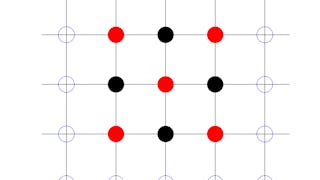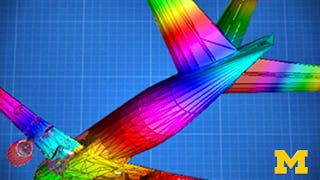Vous souhaitez apprendre à résoudre des équations aux dérivées partielles à l'aide de méthodes numériques et à les transformer en codes Python ? Ce cours vous fournit une introduction de base à l'application de méthodes telles que la méthode des différences finies, la méthode pseudo-spectrale, la méthode des éléments linéaires et spectraux à l'équation d'onde scalaire 1D (ou 2D). La dérivation mathématique de l'algorithme de calcul est accompagnée de codes python intégrés dans des carnets Jupyter. Dans une configuration unique, vous pouvez voir comment les équations mathématiques sont transformées en un code informatique et les résultats visualisés. L'accent est mis sur l'illustration des ingrédients mathématiques fondamentaux des différentes méthodes numériques (par exemple, les séries de Taylor, les séries de Fourier, la différenciation, l'interpolation de fonctions, l'intégration numérique) et sur leur comparaison. On vous fournira des stratégies pour vous assurer que vos solutions sont correctes, par exemple en les comparant à des solutions analytiques ou à des tests de convergence. Les aspects mathématiques sont complétés par une introduction à la physique des ondes, à la discrétisation, aux maillages, à la programmation parallèle et aux modèles de calcul.


Ordinateurs, ondes, simulations : Une introduction pratique aux méthodes numériques utilisant Python

Instructeur : Heiner Igel
26 963 déjà inscrits
(389 avis)
Expérience recommandée
Ce que vous apprendrez
Comment résoudre une équation aux dérivées partielles à l'aide de la méthode des différences finies, de la méthode pseudo-spectrale ou de la méthode linéaire (spectrale) des éléments finis.
Comprendre les limites des simulations spatio-temporelles explicites en raison du critère de stabilité et des exigences en matière d'échantillonnage spatial et temporel.
Stratégies de planification et de mise en place de tâches de simulation sophistiquées.
Stratégies permettant d'éviter les erreurs dans les résultats de simulation.
Compétences que vous acquerrez
- Catégorie : Informatique distribuée
- Catégorie : Equations différentielles
- Catégorie : Mathématiques appliquées
- Catégorie : Mécanique
- Catégorie : Simulations
- Catégorie : Analyse technique
- Catégorie : Programmation en Python
- Catégorie : Vibrations
- Catégorie : Modélisation mathématique
- Catégorie : Calculs d'ingénierie
- Catégorie : Méthodes des éléments finis
- Catégorie : Jupyter
- Catégorie : Analyse numérique
Détails à connaître

Ajouter à votre profil LinkedIn
9 devoirs
Découvrez comment les employés des entreprises prestigieuses maîtrisent des compétences recherchées

Il y a 9 modules dans ce cours
L'utilisation de méthodes numériques pour résoudre les équations aux dérivées partielles est motivée par des exemples tirés des sciences de la Terre. Les concepts de discrétisation dans l'espace et le temps sont introduits et la nécessité d'échantillonner les champs avec une précision suffisante est expliquée (c'est-à-dire le nombre de points de grille par longueur d'onde). Les maillages informatiques sont discutés et leur puissance et leurs restrictions pour modéliser des géométries complexes sont illustrées. Les bases des ordinateurs parallèles et de la programmation parallèle sont abordées, ainsi que leur impact sur les simulations réalistes. L'équation aux dérivées partielles spécifique utilisée dans ce cours pour illustrer diverses méthodes numériques est présentée : l'équation des ondes acoustiques. Certains aspects physiques de cette équation sont illustrés et permettent de comprendre ses solutions. Enfin, nous introduisons les carnets Jupyter qui sont utilisés avec des programmes Python pour illustrer l'implémentation des méthodes numériques.
Inclus
6 vidéos1 lecture1 devoir1 laboratoire non noté
Au cours de la deuxième semaine, nous présentons les définitions de base de la méthode des différences finies. Nous apprenons à utiliser les séries de Taylor pour estimer l'erreur des approximations des dérivées par la méthode des différences finies et à augmenter la précision des approximations en utilisant des opérateurs plus longs. Nous apprenons également à implémenter les dérivées numériques en utilisant Python.
Inclus
8 vidéos1 devoir3 laboratoires non notés
Nous développons l'algorithme des différences finies pour l'équation des ondes acoustiques en 1D, discutons des conditions aux limites et de la manière d'initialiser un exemple de simulation. Nous examinons les solutions en utilisant l'implémentation Python et observons les artefacts numériques. Nous dérivons analytiquement l'un des résultats les plus importants de l'analyse numérique - le critère CFL qui conduit à un algorithme conditionnellement stable pour les schémas explicites de différences finies.
Inclus
9 vidéos1 devoir2 laboratoires non notés
Nous développons la solution de l'équation des ondes acoustiques en 2D, la comparons aux solutions analytiques et démontrons le phénomène d'anisotropie numérique (non physique). Nous étendons l'analyse de von Neumann à la 2D et dérivons l'anisotropie numérique analytiquement. Nous apprenons à initialiser un problème physique réaliste et illustrons que les solutions 2D sont déjà très puissantes pour comprendre les phénomènes ondulatoires complexes. Nous avons introduit l'équation des ondes élastiques 1D et montré le concept des schémas à grille décalée avec la formulation couplée vitesse-contrainte du premier ordre.
Inclus
10 vidéos1 devoir5 laboratoires non notés
Nous commençons par le problème de l'interpolation des fonctions, ce qui nous amène au concept des séries de Fourier. Nous passons aux séries de Fourier discrètes et mettons en évidence leurs propriétés d'interpolation exactes sur des grilles spatiales régulières. Nous introduisons la dérivée des fonctions en utilisant les transformées de Fourier discrètes et nous l'utilisons pour résoudre l'équation des ondes acoustiques 1D et 2D. La nécessité de simuler des ondes dans des zones limitées nous amène à définir les polynômes de Chebyshev et à les utiliser comme fonctions de base pour l'interpolation de fonctions. Nous développons le concept de matrices de différenciation et discutons d'un schéma de solution pour l'équation des ondes élastiques en utilisant les polynômes de Chebyshev.
Inclus
9 vidéos1 devoir4 laboratoires non notés
Nous introduisons le concept d'éléments finis et développons la forme faible de l'équation des ondes. Nous discutons du principe de Galerkin et dérivons un algorithme d'éléments finis pour le problème d'élasticité statique basé sur des fonctions de base linéaires. Nous discutons également de la manière d'implémenter les conditions aux limites. La méthode de relaxation basée sur les différences finies est dérivée pour la même équation et la solution est comparée à l'algorithme des éléments finis.
Inclus
5 vidéos1 devoir1 laboratoire non noté
Nous étendons la solution des éléments finis à l'équation des ondes élastiques et comparons le schéma de solution à la méthode des différences finies. Pour permettre une comparaison directe, nous formulons la solution de différence finie sous forme de matrice-vecteur et démontrons la similitude entre la méthode linéaire des éléments finis et l'approche de différence finie. Nous introduisons le concept de h-adaptivité, la dépendance spatiale de la taille des éléments pour les milieux hétérogènes.
Inclus
7 vidéos1 devoir1 laboratoire non noté
Nous présentons les principes fondamentaux de la méthode des éléments spectraux en développant un schéma de solution pour l'équation des ondes élastiques 1D. Les polynômes de Lagrange sont discutés en tant que fonctions de base de choix. Le concept d'intégration numérique de Gauss-Lobatto-Legendre est introduit et il est montré qu'il conduit à une matrice de masse diagonale rendant son inversion triviale.
Inclus
7 vidéos1 devoir2 laboratoires non notés
Nous finalisons la dérivation de la solution de l'élément spectral de l'équation des ondes élastiques. Nous montrons comment calculer les dérivées nécessaires des polynômes de Lagrange en utilisant les polynômes de Legendre. Nous montrons comment effectuer l'étape d'assemblage menant au système de solution final pour l'équation des ondes élastiques. Nous démontrons la solution numérique pour des milieux homogènes et hétérogènes.
Inclus
7 vidéos1 devoir2 laboratoires non notés
Instructeur

En savoir plus sur Méthodes de recherche
 Statut : Essai gratuit
Statut : Essai gratuitThe Hong Kong University of Science and Technology
 Statut : Prévisualisation
Statut : PrévisualisationUniversity of Michigan
 Statut : Prévisualisation
Statut : PrévisualisationUniversity of Colorado Boulder
 Statut : Prévisualisation
Statut : PrévisualisationJohns Hopkins University
Pour quelles raisons les étudiants sur Coursera nous choisissent-ils pour leur carrière ?




Avis des étudiants
389 avis
- 5 stars
82,26 %
- 4 stars
14,13 %
- 3 stars
1,79 %
- 2 stars
1,54 %
- 1 star
0,25 %
Affichage de 3 sur 389
Révisé le 8 juil. 2023
Excellent course and instructor, I recommend it to everyone interested in learning numerical modelling .
Révisé le 7 oct. 2019
It was a great course. I think you should had included the lambda parameter into the elastic wave propagation.
Révisé le 11 juil. 2020
This is an excellent course as I have found. The instructor has taught us many important concepts including the detailed codes. I would love to join further courses from Prof. Igel.

Ouvrez de nouvelles portes avec Coursera Plus
Accès illimité à 10,000+ cours de niveau international, projets pratiques et programmes de certification prêts à l'emploi - tous inclus dans votre abonnement.
Faites progresser votre carrière avec un diplôme en ligne
Obtenez un diplôme auprès d’universités de renommée mondiale - 100 % en ligne
Rejoignez plus de 3 400 entreprises mondiales qui ont choisi Coursera pour les affaires
Améliorez les compétences de vos employés pour exceller dans l’économie numérique
Foire Aux Questions
Pour accéder aux supports de cours, aux devoirs et pour obtenir un certificat, vous devez acheter l'expérience de certificat lorsque vous vous inscrivez à un cours. Vous pouvez essayer un essai gratuit ou demander une aide financière. Le cours peut proposer l'option "Cours complet, pas de certificat". Cette option vous permet de consulter tous les supports de cours, de soumettre les évaluations requises et d'obtenir une note finale. Cela signifie également que vous ne pourrez pas acheter un certificat d'expérience.
Lorsque vous achetez un certificat, vous avez accès à tous les supports de cours, y compris les devoirs notés. Une fois le cours terminé, votre certificat électronique sera ajouté à votre page de réalisations - à partir de là, vous pouvez imprimer votre certificat ou l'ajouter à votre profil LinkedIn.
Oui, pour certains programmes de formation, vous pouvez demander une aide financière ou une bourse si vous n'avez pas les moyens de payer les frais d'inscription. Si une aide financière ou une bourse est disponible pour votre programme de formation, vous trouverez un lien de demande sur la page de description.
Plus de questions
Aide financière disponible,

